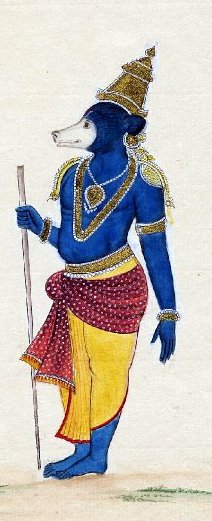Jambavan
In Hinduism, Jambavana also known as Jambavanta is the divine-king of bears, created by the god Brahma to assist the avatar Rama in his struggle against the Lanka king Ravana.[1] Jambavanta is an Asian black bear or sloth bear in Indian epic tradition, though he is also described as a monkey in other scriptures.[1] Jambavana was present at the churning of the ocean and is supposed to have circled Vamana seven times when he was acquiring the three worlds from Mahabali.
| Jambavan | |
|---|---|
 Painting of Jambavan | |
| Affiliation | Divine bear |
| Texts | Ramayana, Bhagavata Purana |
| Personal information | |
| Parents |
|
| Children | Jambavati (daughter) |
Jambavan, together with Parasuram and Hanuman, is considered to be one of the few to have been present for both Ram and Krishna avatars. His daughter Jambavati was married to Krishna. He was also presented for the churning of the ocean and thus witness to the Kurma avatar, and further the Vaman avatar, Jambavan may well be the longest-lived of the Chiranjeevi and have been witness to nine avatars.[2]
NamesEdit
Jambavan is also known as
- Jambavat
- Jambavantha (ಜಾಂಬವಂತ, Kannada script)
- Jamvanta Kannada script
- Jāmbubān (Bangla)
- Champu (Cambodia)
- Jambuwana (Malay)
- Jambuvan (Odia)
- Jambuvaan ( Marathi)
- Jambavan (Malayalam)
- Jāmbavamtudu (జాంబ వంతుడు, Telugu)
- Keeratuvan (Punjabi)[3]
- Zabaman (Burmese)
- Sambuvan (சாம்பவான், Tamil)
- Chomphuphan (ชมพูพาน, Thai)
Several times he is mentioned as Kapishreshtha (Foremost among the monkeys), and other epithets are generally given to the Vanaras. He is known as Riksharaj (King of the Rikshas). Rikshas are earlier described as similar to Vanaras but in later versions of Ramayana, Rikshas are described as bears.
LegendsEdit
BirthEdit
In the beginning when Brahma was born from the navel of lord Vishnu he started meditating and yawned for some time during the yawn a small creature was born which later became Jambavan. It is said he was called jambavan either because he was born on jambudwip or because he was born while yawning. In Sanskrit yawn means Jrimbhan (जृम्भण=yawning). He was present at the time when Lord Vishnu was fighting madhu and kaitabha demons. And was Clapping and enjoying the battle. Since he was born when there was no time his age is not known. At the time of Ramayan he was 6 manvantara old.
Helping RamaEdit
In the epic Ramayana, Jambavantha helped Rama find his wife Sita and fight her abductor, Ravana. It is he who makes Hanuman realize his immense capabilities and encourages him to fly across the ocean to search for Sita in Lanka.[4]
The Syamantaka gemEdit
In the Mahabharata, Jambavantha had killed a lion, who had acquired a gem called Syamantaka from Prasena after killing him. Krishna was suspected of killing Prasena for the jewel, so he tracked Prasena's steps until he learned that he had been killed by a lion, who had been killed by a bear. Krishna tracked Jambavantha to his cave and a fight ensued. The combat between Krishna and Jambavan ensued for 27/28 days (per Bhagavata Purana) and 21 days (per Vishnu Purana) after which Jambavan began to grow tired. Then realizing who Krishna was, Jambavantha submitted. He gave Krishna the gem and also presented him his daughter Jambavati, who became one of Krishna's wives.[5]
See alsoEdit
ReferencesEdit
- ↑ 1.0 1.1 Patricia Turner, Charles Russell Coulter. Dictionary of ancient deities. 2001, page 248
- ↑ "Jambavan: The only one who saw Lord Rama and Krishna".
- ↑ Magnotti, Angela; rews. "Jambavan Fights Krishna (Syamantaka Mani Legend, Part 5)".
- ↑ Mani, Vettam (1 January 2015). Puranic Encyclopedia: A Comprehensive Work with Special Reference to the Epic and Puranic Literature. Motilal Banarsidass. ISBN 978-81-208-0597-2.
- ↑ Mani, Vettam (1 January 2015). Puranic Encyclopedia: A Comprehensive Work with Special Reference to the Epic and Puranic Literature. Motilal Banarsidass. ISBN 978-81-208-0597-2.
External linksEdit
- Jambavantha motivating Hanuman for the task of leaping the ocean. in Valmiki Ramayana - Kishkindha Kanda in Prose Sarga 65 - Accessed August 14, 2006.
- Jambavantha - A Rksha Warrior